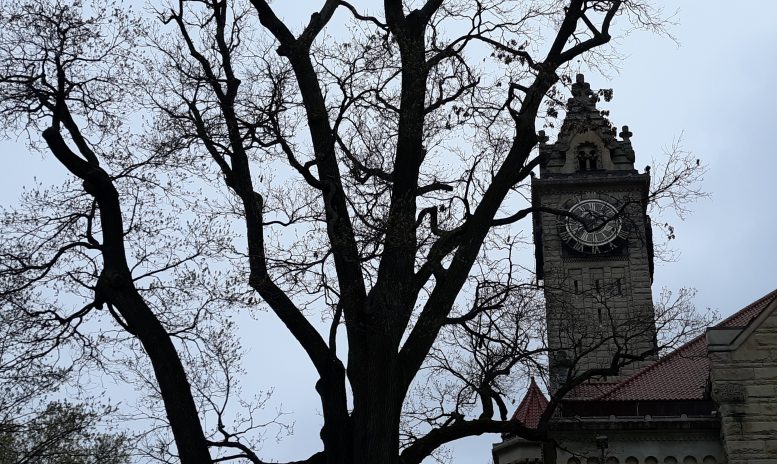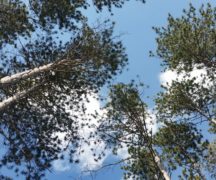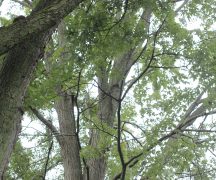By JAN LARSON McLAUGHLIN
BG Independent News
Bowling Green residents are tree huggers of sorts. When trees that have towered over their town for centuries are listed on the chopping block, citizens rush to their defense.
Last year, it was the stately elm at the base of the Conneaut sledding hill. Later it was some trees in the way of the new City Park building. Then a row of trees along the city parking lot on South Church Street.
And this week, it’s two old oaks at the county courthouse – deemed too sick to stay.
When it was announced on Monday that the oaks would be coming down on Friday, citizens began mourning the loss.
“This is so sad. BG losing all of its iconic trees,” one person commented on Facebook. “Conneaut hill and now these.”
But as hard as it is for humans to accept – trees that appear stout and stalwart on the outside, may be weakened and diseased on the inside.
And that’s where Grant Jones – the city’s arborist – comes into the picture. He is the grim reaper of trees in Bowling Green.
The two oaks, standing about 80 feet tall on the east side of the county courthouse lawn, are likely more than a century old, according to Jones, who surmised the trees were planted close to when the courthouse was built.
“They are in poor condition,” said Jones, who agonizes over issuing the death penalty for landmark trees.
“The biggest problem is they have a lot of die-back in the canopy,” with the larger branches dying and no new growth replacing them, Jones said. Then there’s the other tell-tale sign of sickness in a tree – mushrooms growing on the bark.
“It’s a sign that inside that trunk is decaying,” he said.
In this case, the ultimate decision on the fate of the trees was up to the Wood County Commissioners. The county has tried to prolong the lives of the two oaks for the last 20 years, by trimming off the dead parts, according to Wood County Administrator Andrew Kalmar.
“There’s really no choice,” Kalmar said. “It’s becoming a more dangerous situation. We don’t want anyone to be injured. We don’t want the courthouse to be damaged.”
So on Friday, weather permitting, the oaks will come down.
The county is considering new trees for the location.
“It looks like there’s adequate space for new trees,” Jones said.
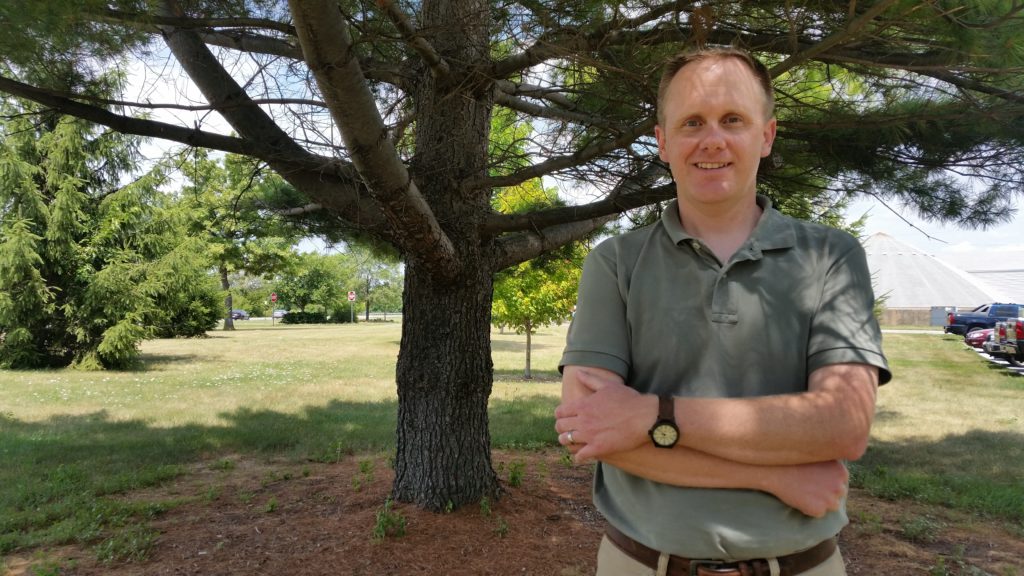
Jones is well aware that citizens become attached to high profile trees in the community. He understands the awe and appreciation people have for aging trees.
“It takes a lot of time for a tree to become a large tree,” he said. “I think there’s an appreciation for the time it takes to get that size.”
And there seems to be an awareness that old trees have grown alongside the community. “I think we wonder what the tree has witnessed over the years,” Jones said.
The arborist keeps those thoughts in mind as he evaluates trees and determines their fates.
“It took a long time for these trees to get there, so you don’t want to rush the decision,” he said. “You want to be thorough in your evaluation.”
But ultimately, the risk posed by an ill tree must be considered – such as with the elm tree at the base of the Conneaut sledding hill.
The towering elm by the hill had long provided shade in the summer and something for sledders to swerve around in the winter. The city had tried for years to stretch out the life of the stately elm. Over the years, some limbs were cabled together in order to shore up the aging tree. But that was only a short-term fix.
In the winter of 2018, a large crack developed, causing part of the tree to separate from the rest.
The giant tree was examined by Bowling Green’s city arborist and by an Ohio Department of Natural Resources arborist. The two came to the same conclusion that the tree posed too big of a risk for people using the park.
“Obviously that was an important tree to a lot of people,” Jones said. “But you have to make the decision based on fact, and not based on emotion.”
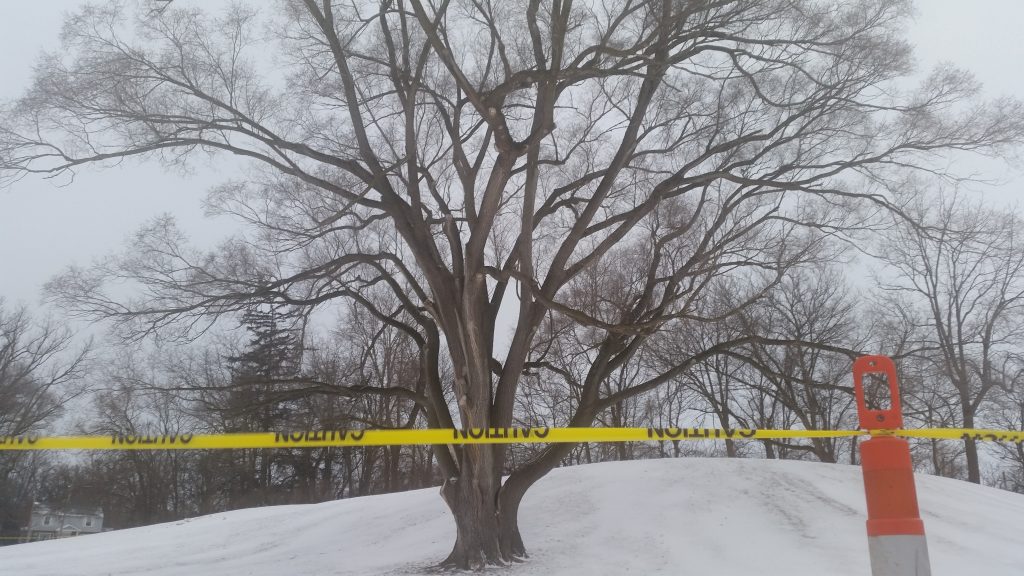
Even trees that aren’t considered “iconic” are often missed by city residents who appreciate the green they add to the landscape. That was the case earlier this spring when the sugar maples and the zelkova trees were cut down along South Church Street. They were in poor condition, and had to be pruned severely over the years due to power lines, Jones said.
“We are planning to replace that area,” he said.
And local residents may want to enjoy the full blossoming pear trees along the downtown streets this spring. The trees have an estimated lifespan of 20 years.
“They are getting toward the upper end of that,” Jones said, adding that the trees will be evaluated later this spring.
“I don’t think there’s any decision made on their future yet,” he said. However, there are concerns about how the trees will survive all the downtown construction.
“We’ll see how they respond to that,” Jones said.
Though losing trees can be hard, Jones said the city tries to preserve some of the memories by turning wood from icons like the sledding hill tree into benches.
“We try to do that to help them continue on,” he said.
The county commissioners have the same idea. Any viable sections of the oak tree trunks will be salvaged, sawn into lumber, and kiln dried. While there is no immediate plan for use of this lumber, it will be saved for a future project of importance to Wood County.
The remaining limbs will be cut into firewood lengths, stacked at the curb lawn along Summit Street, and will be available free to anyone wishing to take them.
The Arbor Day Foundation has named the City of Bowling Green a 2018 Tree City USA in honor of its commitment to effective urban forest management.
The city also received a Tree City USA Growth Award for demonstrating environmental improvement and higher level of tree care. This is the 39th year Bowling Green has been recognized as a Tree City and the 25th time the city has received the Growth Award.
The city’s Tree City USA program has planted more than 3,425 trees from May 2004 through May 2015.
The goal is to plant the “right tree in the right place” by selecting trees that fit the planting site based on soil type, drainage, infrastructure (power lines, gas lines, water and sewer lines), visibility triangle and long-term capital improvement projects.
As city arborist, Jones coordinates with multiple city departments to include the preservation of trees or tree replacement programs to maintain the canopy effect. All new subdivisions and new business plans are now reviewed by Jones to offer recommendations on future tree plantings and landscape design plans.

